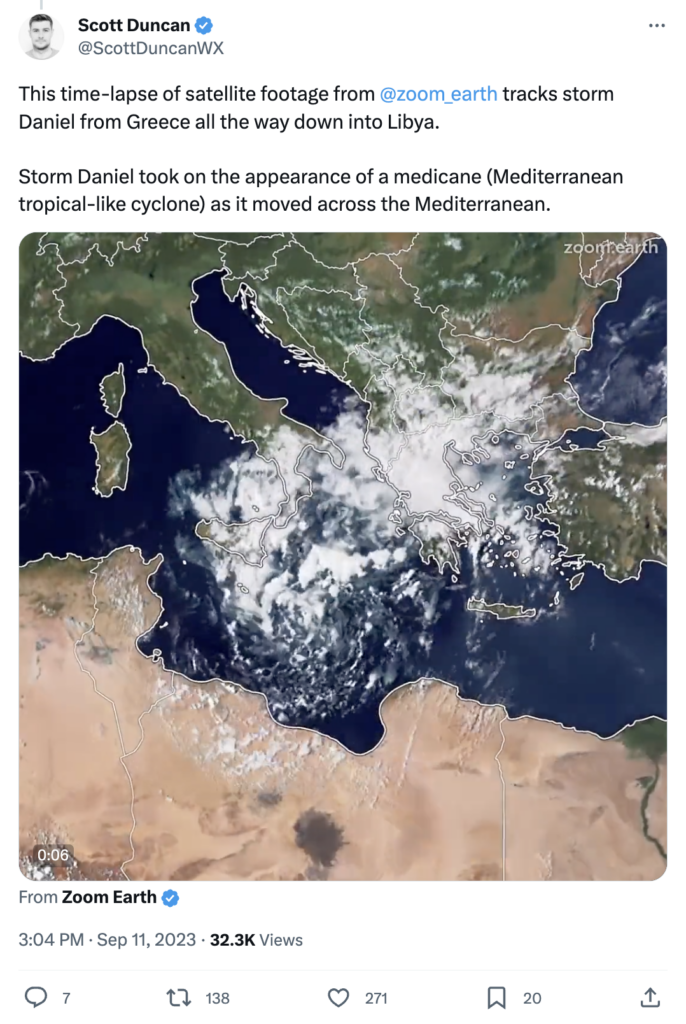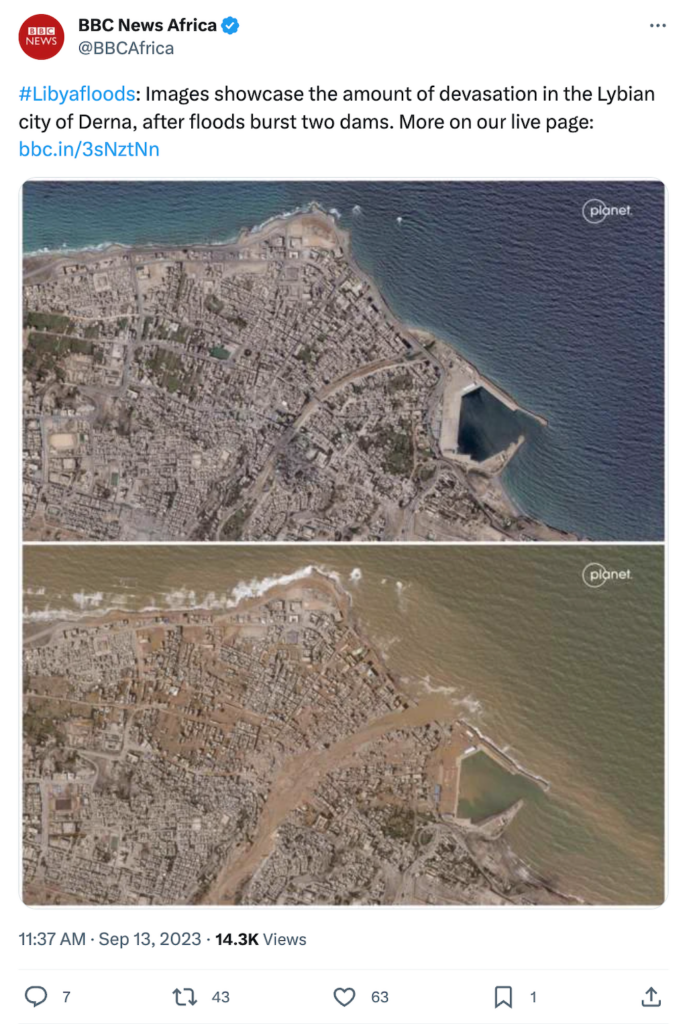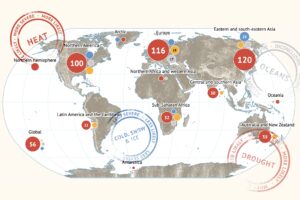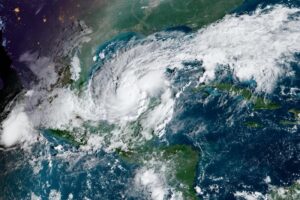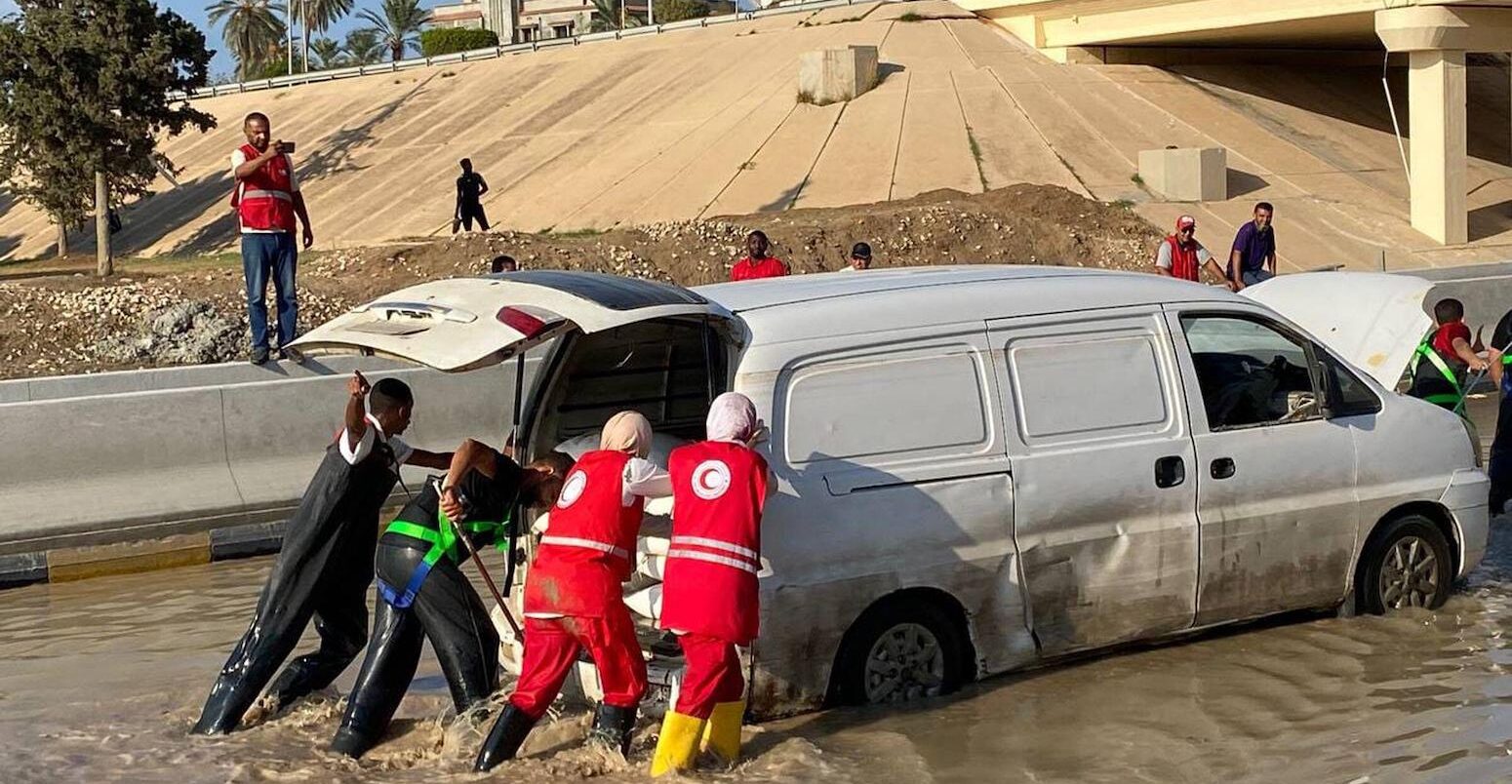
Q&A: How are Libya’s ‘medicane’-fuelled floods linked to climate change?
Multiple Authors
09.19.23Multiple Authors
19.09.2023 | 3:23pmIn early September, Storm Daniel dropped a deluge of rainfall over Greece, Bulgaria and Turkey. It then crossed the Mediterranean Sea, picking up energy from the warm water, and reached its peak intensity over Libya days later.
The storm dropped a torrent of rainfall over the coast of Libya. The water quickly overwhelmed two old and damaged dams in the coastal city of Derna, resulting in tsunami-like waves that swept people and houses out to sea.
The floods have killed at least 11,000 people in Libya and more than 10,000 people are still missing.
The devastating storm is an example of a “medicane” – a hurricane-like storm in the Mediterranean Sea. These typically occur just once or twice every year.
A new “rapid attribution” study estimates that climate change made the extreme rainfall over Libya up to 50 times more likely and up to 50% more intense.
An author on the study told a press briefing that Storm Daniel formed early in the season when sea surface temperatures in the Mediterranean were “very, very high”. This gave the storm energy and helped to “sustain the system for many days”.
The impacts of the storm were compounded by a fragmented government in Libya, lack of clear early warning systems and poor maintenance on the dams, another author explained.
In this Q&A, Carbon Brief explains how the floods transpired, how climate change impacted the event and why the humanitarian impacts were so severe.
- Are Libya’s floods unprecedented?
- How is the flooding linked to medicanes?
- Did climate change play a role in Libya’s floods?
- What other factors worsened flood risk in Libya?
- How is climate change influencing medicanes?
Are Libya’s floods unprecedented?
Storm Daniel is the deadliest and costliest medicane ever recorded.
The storm began life as a low-pressure weather system over the Ionian Sea, which dropped a deluge of rainfall over parts of Turkey, Bulgaria and Greece over 4–5 September.
Around 750mm of rain fell in just 24 hours at a station in the Greek village of Zagora – the equivalent of about 18 months of rainfall. The resulting flooding destroyed infrastructure across the country, forced thousands of evacuations and rescues and killed 15 people.
Meteorologists in Greece have called storm Daniel the worst to hit the country since records began in 1930.
The storm developed the characteristics of a medicane (see: How is the flooding linked to medicanes?) as it moved across the Mediterranean sea, and reached its peak intensity in north-eastern Libya on 10 September where it dropped a deluge of rain.
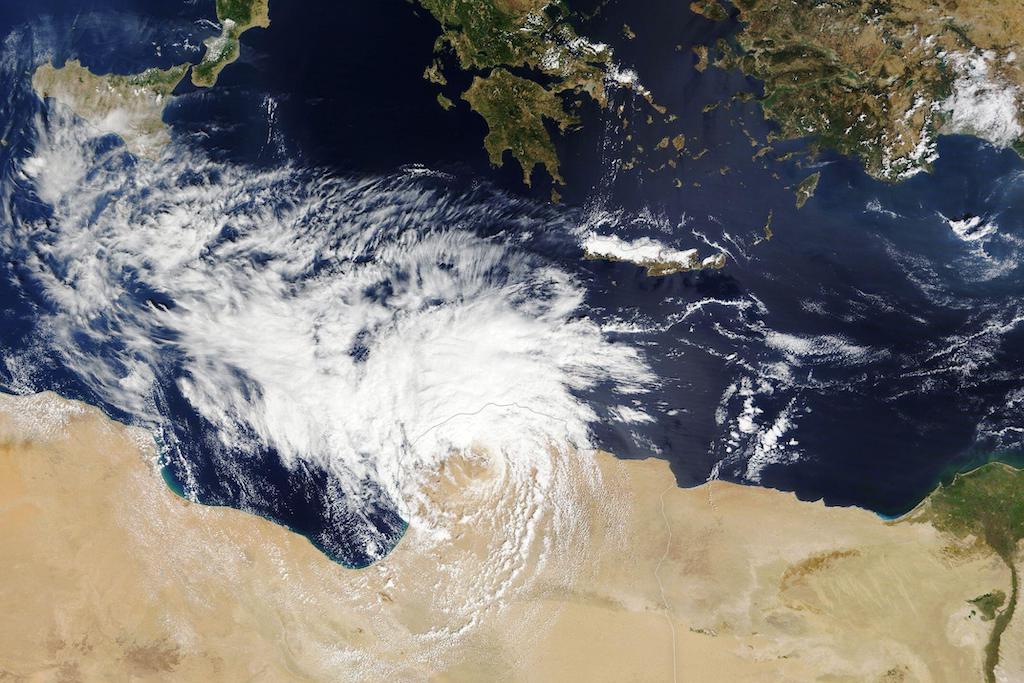
The coastal Libyan city of Al-Bayda recorded a new record daily rainfall high when 414.1mm fell in a 24-hour period over 10-11 September. The storm also hit cities including Benghazi, Susa, Bayda and al-Marj.
The port city of Derna was the worst–affected area in Libya. The city received more than 100mm of rainfall over the course of the storm, far exceeding its September average of less than 1.5mm.
On 10 September around 3am, the swollen Wadi Derna river burst through two dams near the city of Derna, releasing some 30m cubic metres of water into the city in “tsunami-like waves”. (See: “What other factors worsened flood risk in Libya?”)
Disaster unfolding in Libya 🇱🇾
— Scott Duncan (@ScottDuncanWX) September 11, 2023
on the back of Storm Daniel (linked to the system which recently flooded Greece). This footage is from Derna on the north coast of Libya.
More than 2,000 people in Libya are feared dead. Details are still emerging.pic.twitter.com/ukbPKFgGS5
Witnesses said that the water level had reached three metres in height and videos posted to social media showed “extensive damage” to the city, which was home to more than 85,000 people.
Authorities declared Derna a disaster zone. Officials imposed a curfew, while schools and shops were ordered to close.
Initial reports about the number of casualties varied widely. The Red Crescent in Benghazi estimated a death toll of 150-250 people on 11 September. Meanwhile, a spokesperson for the Libyan army in the east, Ahmed Al-Mismari, suggested that as many as 5,000 to 6,000 were missing in the Derna.
Libya has just experienced the deadliest flood of the 21st Century, with 7,000 confirmed dead.
— Colin McCarthy (@US_Stormwatch) September 13, 2023
In the city of Derna, home to 90,000 people, up to 20,000 are feared dead.
25% of the city is estimated to be destroyed after two dams collapsed due to extreme rainfall.
Imagery via… pic.twitter.com/TyVdbl1jbM
In a “choppy” phone interview with local television station Al Masar, eastern prime minister Osama Hamad put the number of confirmed deaths at more than 2,000. “Entire neighbourhoods in Derna have disappeared, along with their residents…swept away by water,” he said.
The flooding wiped out large parts of Derna, leaving behind ruined houses and cars and streets covered in mud. Thousands of people were left trapped under the rubble and the death toll continued to rise as rescue teams uncovered bodies from the debris.

On 12 September, a senior medic said that more than 2,000 people were dead, while eastern Libya officials cited by local television estimated a toll of more than 5,000. “I am not exaggerating when I say that 25% of the city [of Derna] has disappeared,” Hichem Abu Chkiouat, minister of civil aviation in the administration that controls the east, added.
Hundreds of unidentified bodies soon piled up in cemeteries. Outside help only started to reach Derna more than 36 hours after the disaster struck, as the floods had damaged or destroyed many access roads to the city.
Hichem Abu Chkiouat, the minister of civil aviation in the administration that runs eastern Libya, said the “sea is constantly dumping dozens of bodies”. He added that reconstruction will cost billions of dollars.
On 13 September, the Guardian said:
“Corpses still litter the street, and drinkable water is in short supply. The storm has killed whole families and, with the remoteness of some villages and the rudimentary nature of municipal government, it will take time for the death toll to be confirmed.”
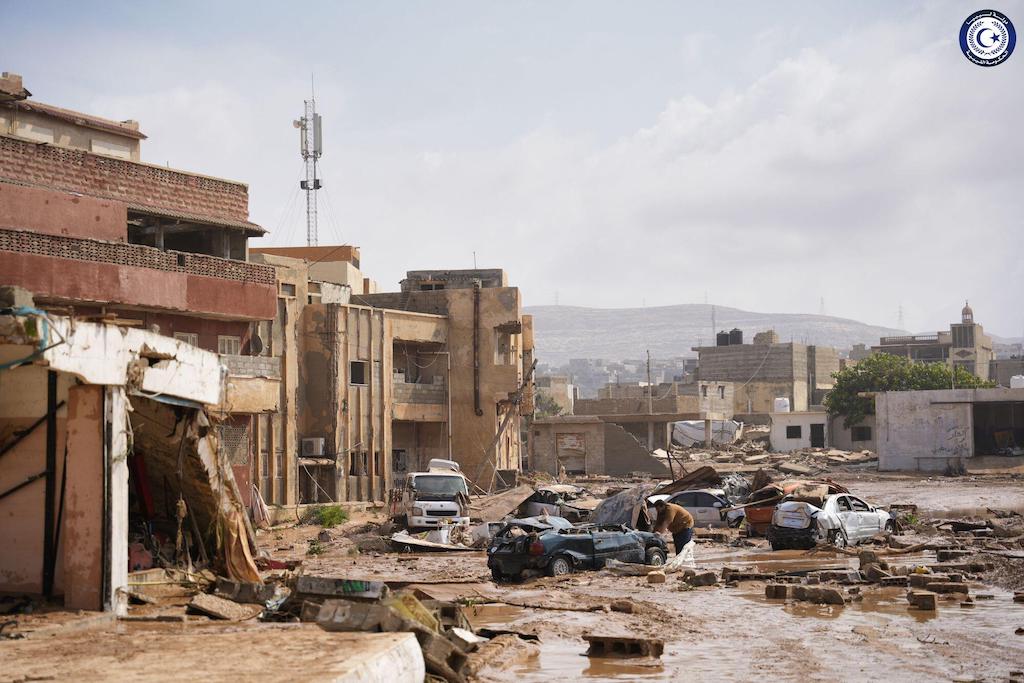
On 17 September, Reuters reported that the death toll from Libya’s floods had reached 11,300. A further 10,000 people are still missing.
How is the flooding linked to medicanes?
A “medicane” is the name given to a storm originating in the Mediterranean Sea that has the physical features of a hurricane, a type of tropical cyclone characterised by a low-pressure centre circled by thunderstorms with high winds.
Medicanes are rare, typically occurring once or twice a year, says Dr Leone Cavicchia, a climate scientist specialising in these kinds of storms at the Euro-Mediterranean Center on Climate Change in Italy.
Most systems originating in the Mediterranean Sea take the form of mid-latitude storms, which have different physical characteristics from tropical cyclones, he tells Carbon Brief:
“There are some quite strict criteria to define a storm in the Mediterranean as a medicane.
“There’s a number of features that we have to look at. For example, the vertical structure of a tropical storm is symmetric, whereas the structure of mid-latitude storms is asymmetric. The clouds of a tropical storm take a very peculiar spiral shape with a hole in the middle, which is called ‘the eye of the hurricane’.”
Scientists typically spot these characteristics by looking at satellite images, adds Dr Emmanouil Flaounas, a scientific researcher specialising in storms at the Hellenic Centre for Marine Research in Greece. He tells Carbon Brief:
“In the satellite images, you get this spiral cloud coverage and a cloudless eye in the middle. This basically qualifies a cyclone as a medicane.”
Storm Daniel first emerged as a mid-latitude storm in Greece before developing the characteristics of a medicane as it headed towards Libya, Cavicchia says:
“It became a medicane in the last phase of its lifetime, just before making landfall in Libya. But the process of transitioning from a mid-latitude storm into a medicane takes some time, so it was very possible that the process was already underway.”
We have a #medicane in the making. Storm #Daniel in the Mediterranean now has tropical characteristics heading south and will make landfall tonight near Benghazi, Libya. The dark shades of purple are winds 50 mph+ pic.twitter.com/3J3ZTnCEDU
— Jeff Berardelli (@WeatherProf) September 9, 2023
Though not defined by metrics such as wind speed or rainfall, medicanes tend to have very severe impacts if they make landfall, Flaounas says.
After making landfall in north-eastern Libya, Storm Daniel unleashed a record 400mm of rainfall in just 24 hours, BBC News reported. The region typically sees just 1.5mm of rain throughout the month of September.
The last medicane to cause major impacts – although it was not anywhere near as deadly – was Storm Ianos in Greece in 2020. The storm brought 100km per hour winds to the Greek islands of Zakynthos, Kefalonia and Ithaca, killing three people, according to Al Jazeera.
The rainfall associated with Storm Daniel was worsened still by a “blocking event” affecting much of Europe and the Mediterranean in September, according to an article in the Conversation by climate scientist Prof Tim Woollings from the University of Oxford.
A “blocking event” is a disruption to the usual weather patterns in the mid-latitudes, which is related to an unusual meandering of the “jet stream”, a fast-moving current of air that encircles the planet. Woolings explained:
“Weather systems effectively ride the jet stream and distort it as they go. On weather maps we see this as a meandering of the jet, veering alternately north and south as it snakes its way east.
“During blocking events, these meanders get larger until eventually the jet breaks up into swirling eddies. With the jet stream disrupted, weather patterns stick around, often for a week or longer. Some places get scorched while others are inundated, day after day.”
The blocking event allowed Storm Daniel to unleash rain over Libya and Greece for longer, according to Woollings. (The same event also facilitated prolonged heat over the UK and France and intense rainfall in Spain.)
Did climate change play a role in Libya’s floods?
As the extent of the damage from Storm Daniel became clear, newspapers began to speculate about the role of climate change in the catastrophic flooding.
On 19 September, the World Weather Attribution service published a “rapid attribution” study on Storm Daniel. Attribution is a fast-growing field of climate science that aims to identify the “fingerprint” of climate change on extreme-weather events, such as heatwaves and droughts.
To put the rainfall into its historical context, the authors analysed a timeseries of the maximum amount of rainfall that Libya has received in a single day each year. The rainfall caused by Storm Daniel was “far outside that of previously recorded events”, and would be expected only once every 300–600 years in today’s climate, they find.
The scientists then used models to compare the world today to a “counterfactual” world without human-caused climate change, in which the climate is 1.2C cooler than that of today.
They find that rainfall as extreme as that observed over Libya has become up to 50 times more likely and up to 50% more intense due to human-caused climate change.
In a press briefing for the WWA study, Dr Lagouvardos Kostas – research director at the National Observatory of Athens and author on the study – explained that Storm Daniel formed early in the season when sea surface temperatures in the Mediterranean were “very, very high”. This gave the storm energy and helped to “sustain the system for many days”.
The authors also performed the analysis for affected European countries. They find that a 24-hour rainfall event of the intensity seen this month is expected once every 10-40 years on average in today’s climate over Spain, and once every 80-250 years in central Greece.
Meanwhile, the four-day extreme rainfall over a larger region including Greece and parts of Bulgaria and Turkey would be expected every 5-10 years in today’s climate. The authors find that for this larger region, climate change made the rainfall up to 10 times more likely and 40% more intense.
(These findings are yet to be published in a peer-reviewed journal. However, the methods used in the analysis have been published in previous attribution studies.)
What other factors worsened flood risk in Libya?
In the days and weeks following the storm, newspapers reported on a range of factors that contributed to the high death rate in Derna due to Storm Daniel.
In a press briefing for the WWA study, Maja Vahlberg – a climate risk consultant from the Red Cross Red Crescent Climate Centre and author on the study – said the “big driver” was the “volume of water and overnight timing of the dam failures”.
The dams, made from rocks, clay and earth, were built by a Yugoslav construction company in the 1970s above the Wadi Derna river, which divides the city. Vahlberg added that the dams were probably not built to withstand an event as extreme as Storm Daniel. However, she said further investigation will be needed to confirm this.
The larger of the two dams, named Abu Mansour, was 14km from the city, 74 metres high and could hold up to 22.5m cubic meters of water. The Derna dam, also known as Belad, was much closer to the city and could hold 1.5m cubic metres of water.
In 1986, a major storm hit the region and damaged the dams. However, “repairs were minimal” and in 1998, the Libyan government commissioned a study that revealed cracks and fissures in the dams.
In 2007, Turkish firm Arsel Construction Company Ltd. was contracted to carry out maintenance on the two dams and build another dam in between. However, the government “dragged its feet” in paying, and the project only began in 2010.
Just four months later, in 2011, Libyans marched against Colonel el-Qaddafi’s 42-year period in power, beginning the Libyan Revolution, and many Turkish companies with projects in Libya fled the country.
According to the Independent, Arsel Construction Company Ltd says on its website that it completed its work in November 2012. But the outlet says that, according to recent satellite photos, “no third dam appeared to have ever been built”.
Many outlets cited research published last year by Abdelwanees Ashoor – a hydraulic engineer at Omar Al-Mukhtar University in Libya – on the vulnerability of the dams, which warned that the residents of Derna are “extremely vulnerable to flood risk”.
The dams “were an accident waiting to happen, especially because poorly constructed housing built close to the river had become increasingly dense and high-rise,” the Guardian said.
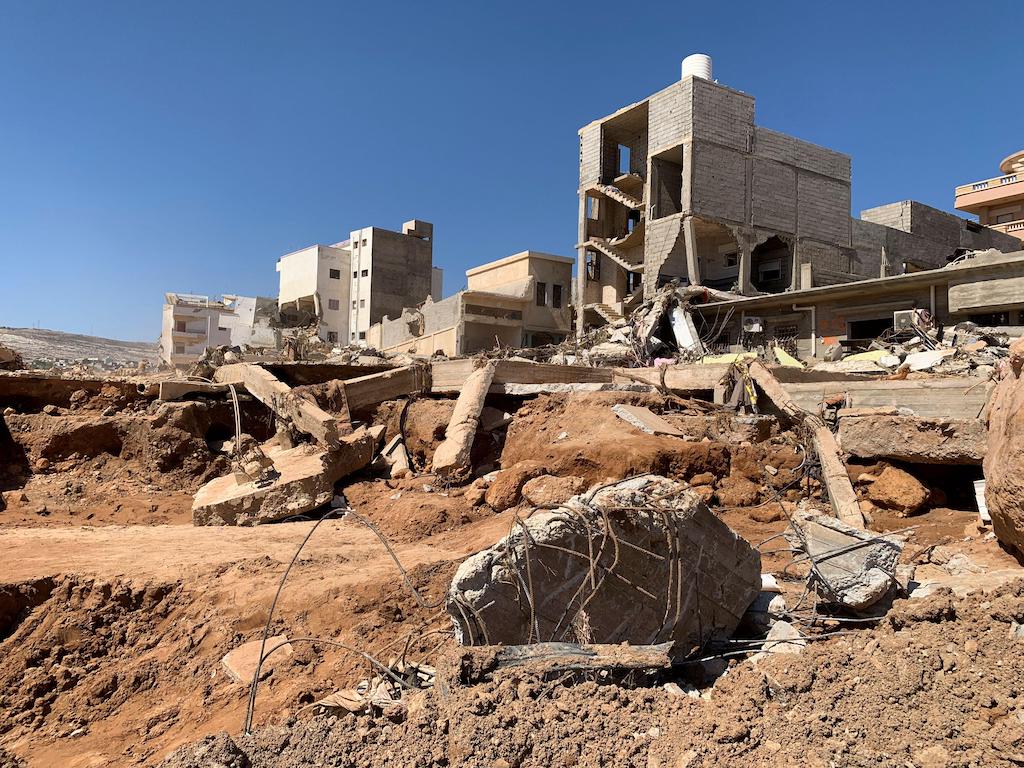
There were also other contributing factors to the disaster in Derna – not least the political instability in the country. Libya is politically divided between east and west and “public services have crumbled” since the 2011 uprising, said Reuters. The internationally recognised government in Tripoli does not control the country’s eastern areas.
The New York Times reported that the political instability was a key factor behind the high mortality rate in Libya:
“Analysts said the country’s woes – political division, economic instability, corruption, environmental degradation and dilapidated infrastructure – seemed to coalesce in one catastrophe when the dams south of the city collapsed.”
The Libyan National Meteorological Centre issued early warnings for the storm 72 hours before it struck and notified all governmental authorities. While the warnings were issued for heavy precipitation and floods, they did not address the risk posed by the ageing dams.
No evacuation instructions were given as the storm neared, the Guardian reported, adding that “instead, a curfew was imposed, the standard response of Libyan militias to any crisis”. World Meteorological Organisation secretary-general Petteri Taalas later told reporters that casualties could have been avoided if the “divided country” had a “functional weather service” able to issue warnings.
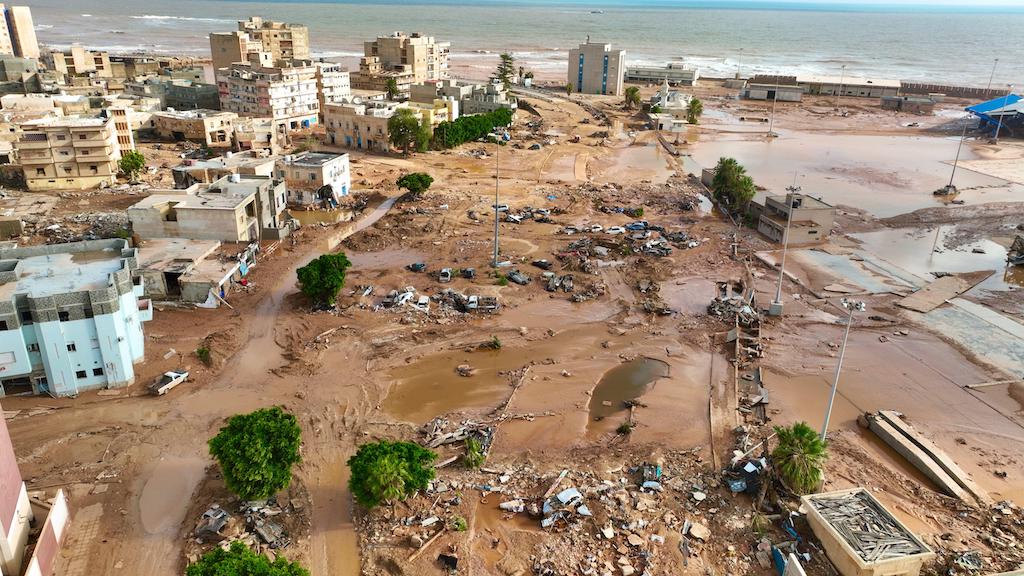
“The precise number dead is hard to gauge with communications down and administration hampered by a decade-long battle for power between two rival governments each backed by their own militias,” the Guardian said in its coverage of the disaster.
“When the climate crisis meets a failed state, the outcome is the kind of disaster that Libya is witnessing in Derna,” the newspaper reported separately.
On 18 September, hundreds of protesters gathered in Derna’s Sahaba Mosque, many chanting for top officials in Libya’s eastern government to be sacked, BBC News reported. It added:
“The home of Derna’s mayor, Abdulmenam al-Ghaithi, has become a focal point for people’s anger. Residents say they were not sufficiently warned by officials, who they believe must have known a huge amount of rainfall was coming. They say they were also given a stay-at-home warning rather than told to evacuate, although officials deny this.”
How is climate change influencing medicanes?
While the WWA team specifically examined the influence of human-caused climate change on the rainfall behind the recent flooding in Libya and Greece, other scientists have been looking into how a hotter planet could affect medicanes more broadly.
There is evidence to suggest that medicanes could be becoming more intense because of human-caused climate change, scientists tell Carbon Brief.
This is happening via two main avenues, Cavicchia says.
The first is linked to the impact of climate change on sea surface temperatures in the Mediterranean, he explains:
“Medicanes are basically regular storms in the Mediterranean that at some point turn into something similar to a hurricane. One of the features that is linked to this evolution is very high temperatures of the sea surface.”
Mediterranean storms typically form in autumn under a specific set of conditions, including warm sea surface temperatures interacting with cool air coming in from higher altitudes.
When sea surface temperatures are extremely high, it allows storms to gather up more “fuel” as they travel over the ocean – making them stronger when they eventually make landfall, Flaounas adds.
Sea surface temperatures in the Mediterranean have increased by 0.29-0.44C per decade since the 1980s, according to the most recent assessment from the world’s authority on climate science, the Intergovernmental Panel on Climate Change (IPCC).
The Mediterranean has seen unusually high sea surface temperatures every summer for the past few years, Cavicchia says. In July, sea surface temperatures in the Mediterranean reached 28.4C, the highest on record, according to the Independent. The previous record was 28.25C, recorded in August 2003.
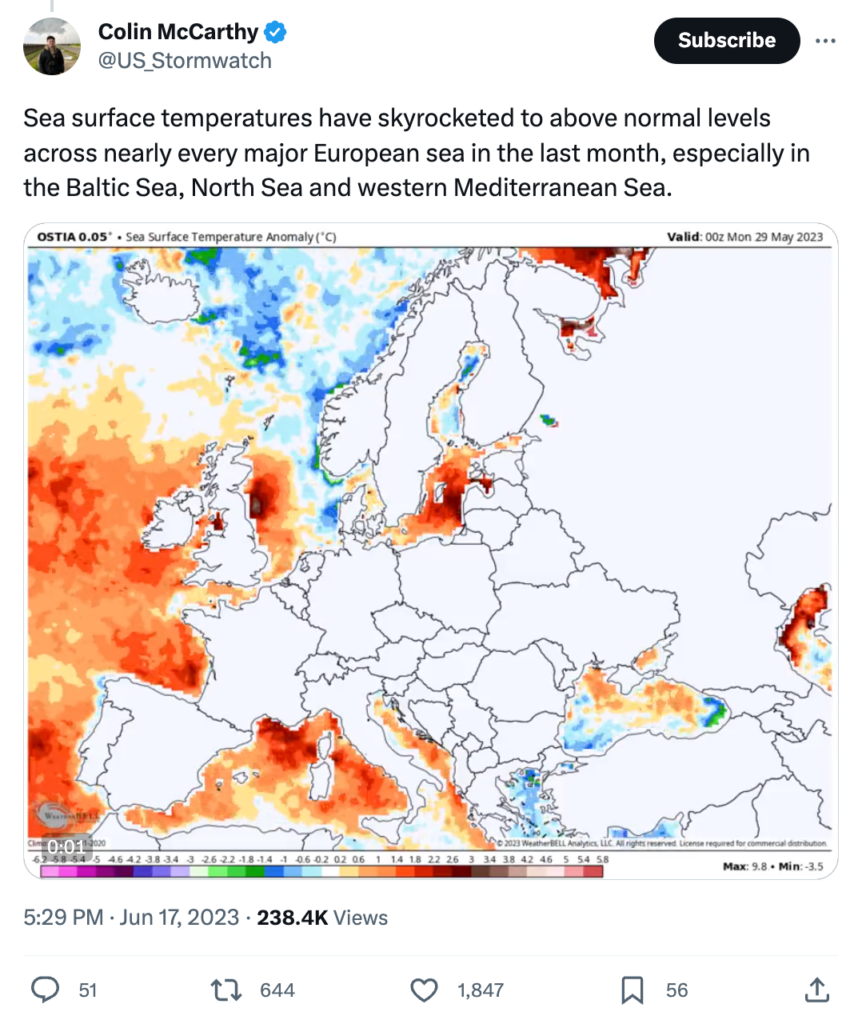
The second way that climate change could be increasing the intensity of storms is through its effect on rainfall, Cavicchia says:
“The warmer the atmosphere gets, the more water can accumulate. For each 1C of temperature increase, the amount of water that the atmosphere can hold increases by about 7%. This is based on basic physics principles.”
(There is evidence that short episodes of extreme rainfall may increase even beyond this 7% with climate change.)
A study using climate models published in 2019 found that medicanes could become “more hazardous” in the coming decades, “lasting longer and producing stronger winds and rainfall”, if global emissions increase at an “intermediate” rate (under the RCP4.5 scenario).
The research added:
“These changes are associated with a more robust hurricane-like structure and are mainly confined to autumn.”
More intense medicanes could pose a particular risk in the Mediterranean, which is characterised by densely packed coastal cities, Flaounas says.
It is also worth noting that there is currently a gulf in medicane preparedness between the two sides of the Mediterranean basin, Cavicchia adds, with north African countries such as Algeria, Libya and Egypt having far fewer resources than European nations.
The 2019 study also found that medicanes might decrease in frequency in a warmer world.
Both Cavicchia and Flaounas tell Carbon Brief that it is currently difficult to draw conclusions about how climate change might affect the frequency of medicanes.
One reason for this is because medicanes are currently rare – occurring once or twice a year – and storm records for the Mediterranean extend back only a few decades. This leaves scientists with little data to analyse how the frequency of medicanes is changing.
Another reason is that is currently difficult to study medicanes using global climate models, Cavicchia says:
“To study these events in the future, you rely on climate simulations. But since these storms are on quite a small spatial scale, global climate models are not yet able to resolve them. So for the future, we don’t have a large amount of data to draw conclusions.”


